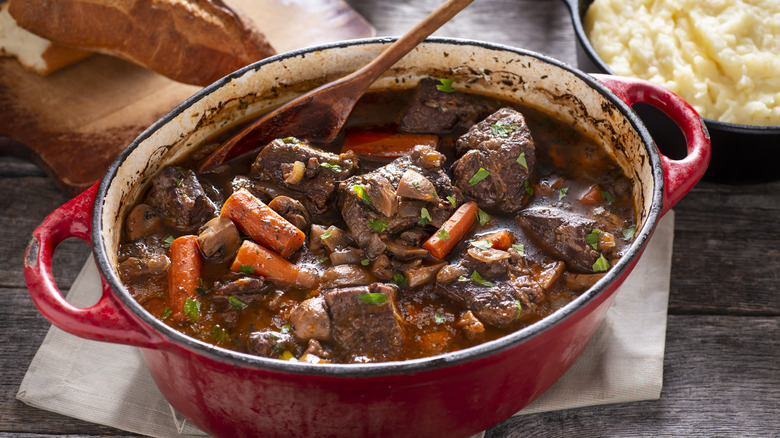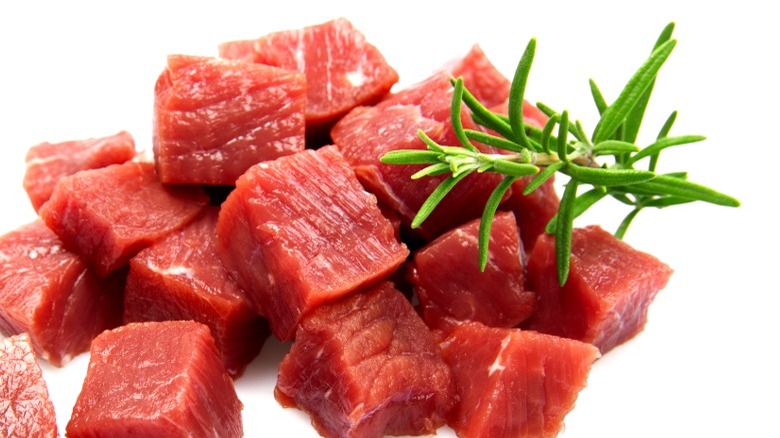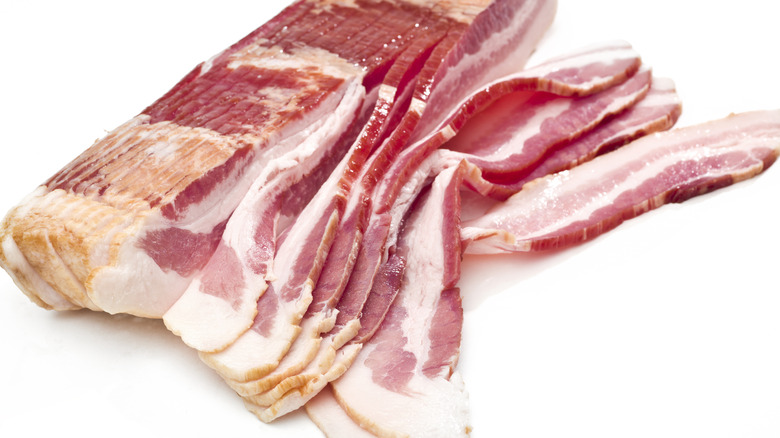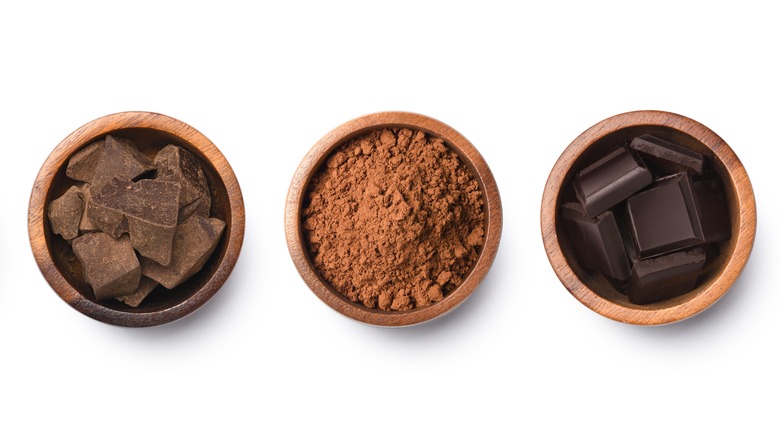15 Ingredients That Will Add More Flavor To Beef Stew
Whether you have a few ingredients or an entire pantry at your disposal, creating mouth-watering beef stew is something anyone can handle. Chefs and butchers alike will tell you the best flavor starts, of course, with the right cut of meat — but beef stew doesn't require expensive cuts to give you that deep, hearty taste that signals the comfort of stew. Nor does it require some fancy-schmancy, hard-to-find ingredient to make it the hit of dinner.
Many cuts of beef work well in a stew, but your best cuts are the cuts that are considered the toughest. Look for shank, neck, chuck, and brisket cuts of beef; these cuts are somewhat fatty but full of connective tissue. As the cuts cook slowly, as in stew, the fat seasons the meat while the connective tissue turns into soft collagen. Both actions turn the beef into a tender and tasty piece of meat while also creating your base sauce.
From simple seasonings like herbs and spices to fresh, whole foods like vegetables and legumes, a number of items pair well with a good cut of red meat to help you add more flavor to beef stew recipes. We're presenting to you a list of foods that bring out the best of beef — including some you might not expect.
1. Salt
Though it may seem like an obvious seasoning to add to beef stew, salt is often underestimated in the flavor it lends. Because different salts are made up of different combinations of minerals, each combination often comes with its own distinct salty taste.
Most people are familiar with iodized table salt that comes out of a shaker, but many other salts, such as kosher, sea, and Himalayan are also popular. Compared to table salt, kosher salt is slightly less salty, a little larger in flake, and doesn't have added ingredients. Sea salt and Himalayan pink salt are available from fine to coarse and are often found in grinders. They contain more minerals and provide a clean taste.
Coarse sea or Himalayan salt, as well as other salts such as fleur de sel and sel gris, are considered best as finishing salts. We recommend salting your stew with one type of salt while cooking and using a finishing salt for serving. Don't be afraid to keep more than one type of salt in your pantry alongside your other seasonings.
2. Rosemary
Rosemary makes a popular pairing with hearty cuts of meat by adding a delicate balance of bitter and sweet. With choices from dried leaves to fresh sprigs of rosemary, there are a number of ways to add a bittersweet flavor to your beef stew. One thing to remember about rosemary, though, is that a little goes a long way, whether dried or fresh. It can be added at the beginning of cooking, but it's often added near the end of cooking — anywhere from one to two hours before completion — because of its strong taste.
Fresh is best and you can leave the sprig of rosemary intact when you throw it in your pot of beef stew, but don't eat the stem. Aim for one to three fresh sprigs, 1 tablespoon of chopped fresh leaves, or 1 teaspoon of dried leaves for about 1 to 2 pounds of beef. Other herbs, spices, and ingredients that complement rosemary and beef are parsley, sage, thyme, onion, garlic, red wine, and carrots.
3. Bacon
Packing a wallop of flavor to old-fashioned beef stew, bacon is a rich, salty, and smoky addition to the rendering beef juice. It's available in a wide variety of cuts and seasoning combinations. From thin-sliced to thick-cut, from fresh pork belly to aged and cured, and from apple- to hickory-smoked, bacon provides a range of options for adding more flavor to your beef stew. Ask your butcher to chop up some pork belly the same size as your beef cuts. Toss the chunks of pork belly or other thick-cut bacon in with your beef as it cooks.
Alternatively, you can sear your beef chunks alongside sizzling bacon strips before you start slow cooking them as another way to add some umami to the meat. Consider using smoked versions, such as applewood, hickory, oak, maple, or mesquite, to bring a subtle undercurrent of flavor that will have eaters wondering what the secret is. But whether you wrap uncooked bacon around beef chunks while the stew simmers or toss in crispy-cooked bacon pieces as a finishing touch, cured pork takes beef stew to another culinary level.
4. Mushrooms
Mushrooms are a dense, flavorful food with a meaty texture, making it a culinary companion to beef. Besides adding a deep, earthy, or nutty savor to the beef stew, mushrooms act as a thickening agent, which helps create a thicker stew. With countless types of mushrooms to consider, we suggest you use multiple kinds in your beef stew.
Not all mushrooms cook the same, however, so when and how you add them to your beef stew matters. Some types of mushrooms cook better whole rather than being cut into pieces. Whole mushrooms fare better during the slow cooking process; cut pieces tend to fall apart in your pot. Mushrooms such as porcini and portobello are great thrown in whole at the start of cooking. Other types like shiitake, oyster, and beech mushrooms do better when added later in the cooking process.
5. Coffee
Coffee isn't just a breakfast staple — it's a sneaky way to further enhance the robust nature of beef. And with a wide variety of coffee brands to choose from, the options are seemingly endless. It may not be the first thing you think of when wondering what new flavor you can bring to your stew, but the deep, slightly bitter bite of coffee can add depth to your sauce base. And if you choose a flavored coffee, you could turn your beef stew into a game-changing meal. Keep in mind to continue the seasoning profile that matches your chosen flavored coffee throughout your beef stew.
For roughly 2 to 3 pounds of beef, add about 2 to 3 cups of your choice of brewed coffee to your pot at the start of cooking. Alternatively, add the right amount of instant coffee, per the package, along with enough water to yield 2 to 3 cups of brewed coffee. For cautious folk, experiment with a mild coffee. If you drink coffee regularly, try a dark roast or espresso. If you're more adventurous, consider coffee enhanced with pumpkin spice, cinnamon, maple, hazelnut, apple, or pecan.
6. Cacao
Another unexpected ingredient to add more flavor to beef stew is cacao or cocoa, like in Sandra Lee's beef stew with chocolate recipe. Whether you choose to sprinkle in some cacao powder or melt a few squares of dark chocolate, this bean adds an intense, rich (and maybe sweet) essence to your beef stew. It can also help thicken the stew up a bit. But unless you want it to turn into dessert, use the cacao or chocolate sparingly and only as an added seasoning for the stew, not as a main ingredient.
Cacao is similar to coffee in that it adds a deep earthy taste, creating a richer sauce base. Though cacao powder can be sprinkled directly on the meat and is often used in barbecue spice rubs, mixing it in with your liquid base better suits your stew. Alternatively, melt 2 to 3 ounces of your choice of milk or dark chocolate and mix it into your liquid base. Like coffee, try different flavor varieties of cocoa or chocolate.
7. Orange
Orange and beef are a happy combination, and whether you choose sweet or bitter or use peel or juice, oranges can bring a fresh citrus element to beef stew. Sweet oranges are the oranges most people are familiar with — you eat them by hand or slice and grill them. The rind, flesh, or juice of sweet oranges are also used in baked goods, desserts, and smoothies. Bitter or sour oranges are not eaten like sweet oranges and feature a dry flesh, but the rind is great for grating. It's the type of orange you tend to find in orange marmalade, candy, or syrups.
Add more flavor to your beef stew with juice from an orange. In addition to enhancing your stew with a nice tangy bite, the acid in the citrus fruit helps tenderize the beef as it slow cooks. But be careful with the amount of orange juice or zest you add to your stew — too much may detract from your dish by becoming more bitter and creating tough meat. Try the juice from one orange and remember to continue your seasoning profile throughout the dish.
8. Garlic
For some people, garlic is a given. But the sky is nearly the limit when adding garlic to beef stew. It can be either the focus of the dish or simply a highlight. The unmistakable kick of tang, bitterness, and heat doesn't just make it stand out — it creates a divide among the masses, pitting those who love it against those who agree it should remain a vampire-repellant.
Though fresh will give you the best that garlic has to offer, it's also available readily minced or chopped, usually packed in water or oil. Pre-cut jarred garlic and garlic powder don't keep as much of the allium's original taste and punch, but it's handy to have on hand and can still add more flavor to your beef stew. But if you're going to use garlic, it's worth learning how to buy fresh garlic so you have it at the ready.
You've heard the joke. When a recipe calls for one clove of garlic, use the whole head. And some people probably do. If you're new to garlic, toss a clove or two in with your beef stew to give it a try. If you're a garlic veteran, then you already know how much you want to use. Just leave the cloves whole and add them in along with your other ingredients — you can stop mincing garlic for stew.
9. Onions
From small to large and sweet to spicy, with taste components as multi-layered as the vegetable itself, the onion has made its way into kitchens around the world adding a recognizable aroma to recipes. The most popular types of onions are storage onions — the white, yellow, and red varieties you often see in the produce aisle. They carry a mild to sharp bite, the raw onion holding the most pungency versus cooked. Spanish onions, sometimes included in this category, are a milder version of the white or yellow onion.
Many beef stew recipes will specify what type of onion to use, and if you're not sure, choose a white or yellow onion. If you're just whipping up a batch of stew and are open to options, consider other types of onions, such as sweet onions, cipollini onions, pearl onions, or scallions for garnish, to further customize your stew profile.
Onions, like cut potatoes and carrots, are typically added to stews closer to the end of cooking time so the onion doesn't disintegrate or turn to mush. This is a good opportunity to use small whole onions, such as pearl or cipollini onions, since they're more apt to simmer into a tender piece of umami that's sweet, savory, and spicy all at once. But if you really want to change things up, caramelize your onions before adding them to your stew. Caramelized onions bring a rich layer of roasted sweetness that deepens the essence of the stew base.
10. Peppercorn
What goes well with the light acidic tang of red meat? A sharp, spicy bite. Peppercorns are recognizable due to their wrinkled appearance and small round shape. Used as both a cooking and table spice, the peppercorn is actually a fruit that grows on a flowering vine. How do you know which peppercorn to use to add more flavor to your beef stew? Follow your recipe or experiment with the different types of peppercorns available.
White peppercorns (the result of removing the skin of black peppercorns) are also spicy and will add kick to your stew. Pink peppercorns are technically dried Brazilian berries and instead of being spicy, they're sweeter and carry a fruity, floral flavor. The pink peppercorn, better used as a garnish, goes well with a citrus beef stew. Green peppercorns are typically brined and can add a tart, slight spiciness to your beef dish. Like salt, experiment with one type of peppercorn for cooking, such as black or white pepper, and one type for finishing, such as pink or green peppercorns.
11. Cinnamon
Cinnamon isn't just for your cookies or favorite coffee, it's a spice that enhances the rich taste of beef. Used in cuisines around the world and included in a variety of spice mixes, cinnamon adds a sweet or spicy savor (often both) to your beef stew.
The two spices that are labeled as cinnamon are cassia and Ceylon; the former being the most popular to grace American households. Cassia is the familiar taste in various bakery items for its snappy punch. Ceylon is lighter in color, has a more delicate flavor, and is considered true cinnamon. Cinnamon is another seasoning where a little goes a long way and it's available in rolled sticks or ground powder.
To add this earthy spice to your beef stew, subtly enhance the taste with cinnamon sticks or add deeper potency with ground cinnamon. Add about two cinnamon sticks or 2 teaspoons of ground cinnamon for 2 to 3 pounds of beef. Or choose a spice mix such as garam masala or jerk.
12. Potatoes
Meat and potatoes have been married as long as culinary time. Potatoes contribute depth and add an earthy nature to your stew, but they can also take on the flavor of the stew itself, making it a fairly obvious choice to add. Potatoes help thicken your beef stew as well.
Since the starch absorbs moisture, choose a type of potato that doesn't fall apart into mushy pieces by the time the stew is done. Use a waxy potato to create a better balance of thickening the stew and enhancing palatability. Alternatively, mix up a dense, robust stew by adding instant mashed potatoes or potato flakes or puree, which can quickly thicken and season your base.
Fresh potatoes work well, such as fingerlings, red, new, and baby potatoes. You might be able to get away with gold potatoes depending on how long you simmer your beef stew. They're a little softer than the waxy potatoes and might crumble if cooked too long.
So should you cut the potatoes or leave them whole? Too-small pieces might fall apart if simmered too long, and pieces that are too large could end up too crunchy if not cooked long enough. Add small potatoes whole or cut them in half, like fingerlings, and put them in the stew 30 to 60 minutes before it's done. If you're throwing together a beefy dish in under 30 minutes, toss in cubed potatoes that cook quickly.
13. Carrots
Carrots may seem like a ho-hum way to bring flavor to beef stew but they add a subtly sweet (and maybe spicy) hint to the stew base. Though larger carrots contain more starch and may help thicken your stew, smaller carrots have more taste and may add more value to your dish. Choose from white, yellow, orange, and purple varieties. White, yellow, and orange carrots are the sweeter varieties while purple carrots tend to be on the spicy side.
This root vegetable absorbs moisture and seasoning, taking on the accompanying stew flavors and lending additional savory thickness to your finished meal. But like potatoes, you don't want a mushy or raw end-product, so how and when you add your carrots does matter. The larger and thicker your carrot, the longer it will take to cook. The smaller the carrot, the quicker it could turn to mush. Typically, carrots get added to stew about 30 to 60 minutes before it's set to be done.
14. Red wine
A classic for a reason, adding red wine to your beef stew can only translate into a delicious boeuf bourguignon. So if you're going to add red wine to your beef stew, check out our boeuf bourguignon recipe and do it right.
Red wine is a catch-all term, especially when it comes to the discussion of wine. With choices from the various regions that produce cabernet sauvignon to merlot to pinot noir to your favorite boxed wine, your choice of red wine for beef stew is pretty far-reaching.
Author and creator of "Mastering the Art of French Cooking," Julia Child, suggests a red burgundy as the liquid of choice for knockout beef stew. But what is burgundy? True Burgundy originates from France and is strictly red, using only pinot noir red grapes grown in, you guessed it, the region of Burgundy. Other regions create burgundy wine as well, but it might be red or white. So you could argue that a red burgundy from any region is a good substitute for the real deal, which just means picking up a good quality pinot noir to steep your stew.
15. Stout
Traditionally made with Guinness, Irish beef stew brings regular beef stew to a whole new level. This Irish stout deepens the taste of your stew, bringing undertones of roasted malt and hints of chocolate and coffee, adding layers of richness to the stew's base. Even if you don't have Guinness on hand, you can cook with other stouts and porters to create a tastier, more scrumptious stew.
Porters and stouts are considered dark beers, but porters lean toward notes of chocolate whereas stouts lean toward notes of coffee. Depending on the type of stout you choose, there may also be hints of chocolate, vanilla, caramel, or licorice. But to follow a tried-and-true, Irish-kickin' beef stew, consider the full-bodied, dark, and creamy Guinness as your stew's stout addition. Try adding 15 ounces of Guinness (the equivalent of a can sold at the store) for every 2½ pounds of beef to help create an authentic Killarney beef stew.















